Immature Sword Bean (Canavalia gladiata) Pod Alleviates Allergic Rhinitis (A Double-Blind Trial) Through PI3K/Akt/mTOR Signaling
Abstract
1. Introduction
2. Materials and Methods
2.1. Study Population
2.2. Preparation of the SBP
2.3. Study Design
2.4. Primary Indicators
2.5. Secondary Indicators
2.6. Tertiary Indicators
2.7. Cell Culture
2.8. Real-Time PCR Analysis
2.9. Western-Blot Analysis
2.10. Analysis of ECP Production in EOL-1 Cells
2.11. Analysis of Inflammatory Cytokine and Allergic Mediator Production in HMC-1 Cells
2.12. Statistical Analysis
3. Results
3.1. General Information
3.2. Primary Outcomes
rTNSS
3.3. Secondary Outcomes
3.3.1. iTNSS
3.3.2. RQLQ
3.3.3. PGIC
3.4. Tertiary Outcomes
Inflammatory Cytokine and Allergic-Mediated Factors
3.5. Effect of SBP on Eosinophil Cationic Protein mRNA Expression and Secretion in EoL-1 Cells Induced by Butyrate
3.6. Effect of SBP on Inflammatory Cytokine mRNA Expression and Secretion in HMC-1 Cells Stimulated with Culture Supernatants of EoL-1 Cells
3.7. Effect of SBP on Allergic Mediator Secretion in HMC-1 Cells Stimulated with Culture Supernatants of EoL-1 Cells
3.8. Effect of SBP on PI3K/Akt/mTOR Signaling in EoL-1 Cells
4. Discussion
5. Conclusions
Supplementary Materials
Author Contributions
Funding
Institutional Review Board Statement
Informed Consent Statement
Data Availability Statement
Conflicts of Interest
References
- Akhouri, S.; House, S.A. Allergic Rhinitis. In StatPearls; StatPearls Publishing LLC: Treasure Island, FL, USA, 2024. [Google Scholar]
- Skoner, D.P. Allergic rhinitis: Definition, epidemiology, pathophysiology, detection, and diagnosis. J. Allergy Clin. Immunol. 2001, 108, S2–S8. [Google Scholar] [CrossRef]
- Wu, J.Z.; Ge, D.D.; Zhou, L.F.; Hou, L.Y.; Zhou, Y.; Li, Q.Y. Effects of particulate matter on allergic respiratory diseases. Chronic Dis. Transl. Med. 2018, 4, 95–102. [Google Scholar] [CrossRef] [PubMed]
- Chatkin, J.; Correa, L.; Santos, U. External Environmental Pollution as a Risk Factor for Asthma. Clin. Rev. Allergy Immunol. 2022, 62, 72–89. [Google Scholar] [CrossRef] [PubMed]
- Trends in the Number of Allergic Rhinitis Patients by Year; Health Insurance Review & Assessment Service: Wonju, Republic of Korea, 2022.
- Wise, S.K.; Lin, S.Y.; Toskala, E.; Orlandi, R.R.; Akdis, C.A.; Alt, J.A.; Azar, A.; Baroody, F.M.; Bachert, C.; Canonica, G.W.; et al. International Consensus Statement on Allergy and Rhinology: Allergic Rhinitis. Int. Forum Allergy Rhinol. 2018, 8, 108–352. [Google Scholar] [CrossRef] [PubMed]
- Rothenberg, M.E.; Hogan, S.P. The eosinophil. Annu. Rev. Immunol. 2006, 24, 147–174. [Google Scholar] [CrossRef] [PubMed]
- Paige, L. Cytokine Effector Functions in Tissues; Academic Press: Cambridge, MA, USA, 2017; pp. 173–218. [Google Scholar] [CrossRef]
- Koh, G.C.; Shek, L.P.; Goh, D.Y.; Van Bever, H.; Koh, D.S. Eosinophil cationic protein: Is it useful in asthma? A systematic review. Respir. Med. 2007, 101, 696–705. [Google Scholar] [CrossRef] [PubMed]
- Foreman, J.C.; Lichtenstein, L.M. Induction of histamine secretion by polycations. Biochim. Biophys. Acta 1980, 629, 587–603. [Google Scholar] [CrossRef]
- Piliponsky, A.M.; Pickholtz, D.; Gleich, G.J.; Levi-Schaffer, F. Human eosinophils induce histamine release from antigen-activated rat peritoneal mast cells: A possible role for mast cells in late-phase allergic reactions. J. Allergy Clin. Immunol. 2001, 107, 993–1000. [Google Scholar] [CrossRef] [PubMed]
- Zhuo, J.J.; Wang, C.; Kai, Y.L.; Xu, Y.Y.; Cheng, K.J. The role of autophagy regulated by the PI3K/AKT/mTOR pathway and innate lymphoid cells in eosinophilic chronic sinusitis with nasal polyps. Immun. Inflamm. Dis. 2024, 12, e1310. [Google Scholar] [CrossRef] [PubMed]
- Shamri, R.; Young, K.M.; Weller, P.F. PI3K, ERK, p38 MAPK and integrins regulate CCR3-mediated secretion of mouse and human eosinophil-associated RNases. Allergy 2013, 68, 880–889. [Google Scholar] [CrossRef]
- Luo, X.; Li, C.; Wang, Y.; Yang, G.; Xu, Y.; Li, G.; Liao, F.; Tan, S. Interleukin-33 Promotes Th2/Th17 Response in Eosinophilic and Non-Eosinophilic Nasal Polyps. ORL J. Otorhinolaryngol. Relat. Spec. 2020, 82, 34–39. [Google Scholar] [CrossRef] [PubMed]
- Zhao, Y.; Li, X.; Xu, Z.; Hao, L.; Zhang, Y.; Liu, Z. PI3K-AKT-mTOR signaling pathway: The intersection of allergic asthma and cataract. Pharmazie 2019, 74, 598–600. [Google Scholar] [CrossRef]
- Zoncu, R.; Efeyan, A.; Sabatini, D.M. mTOR: From growth signal integration to cancer, diabetes and ageing. Nat. Rev. Mol. Cell Biol. 2011, 12, 21–35. [Google Scholar] [CrossRef] [PubMed]
- Zhang, Y.; Jing, Y.; Qiao, J.; Luan, B.; Wang, X.; Wang, L.; Song, Z. Activation of the mTOR signaling pathway is required for asthma onset. Sci. Rep. 2017, 7, 4532. [Google Scholar] [CrossRef]
- Zhu, J.; Yamane, H.; Paul, W.E. Differentiation of effector CD4 T cell populations (*). Annu. Rev. Immunol. 2010, 28, 445–489. [Google Scholar] [CrossRef] [PubMed]
- Ma, B.; Athari, S.S.; Mehrabi Nasab, E.; Zhao, L. PI3K/AKT/mTOR and TLR4/MyD88/NF-κB Signaling Inhibitors Attenuate Pathological Mechanisms of Allergic Asthma. Inflammation 2021, 44, 1895–1907. [Google Scholar] [CrossRef] [PubMed]
- Morris, J. Swordbean (Canavalia ensiformis (L.) DC.) Genetic Resources Regenerated for Potential Medical, Nutraceutical and Agricultural Traits; Springer: Berlin/Heidelberg, Germany, 2007. [Google Scholar]
- Hwang, K.A.; Hwang, Y.J.; Hwang, H.J.; Lee, S.H.; Kim, Y.J. Sword Bean (Canavalia gladiata) Pod Exerts Anti-Allergic and Anti-Inflammatory Effects through Modulation of Th1/Th2 Cell Differentiation. Nutrients 2022, 14, 2853. [Google Scholar] [CrossRef]
- Ekanayake, S.; Jansz, E.R.; Nair, B.M. Literature review of an underutilized legume: Canavalia gladiata L. Plant Foods Hum. Nutr. 2000, 55, 305–321. [Google Scholar] [CrossRef]
- Kumar, P.; Reddy, Y.N. Protective effect of Canavalia gladiata (sword bean) fruit extracts and its flavanoidal contents, against azathioprine-induced toxicity in hepatocytes of albino rats. Toxicol. Environ. Chem. 2014, 96, 474–481. [Google Scholar] [CrossRef]
- Hwang, H.J.; Hwang, Y.J.; Kim, Y.J.; Kim, M.; Hwang, K.A. Immature sword bean pods (Canavalia gladiata) inhibit adipogenesis in C3H10T1/2 cells and mice with high-fat diet-induced obesity. J. Chin. Med. Assoc. 2022, 85, 67–76. [Google Scholar] [CrossRef]
- Bae, H.C.; Park, J.U.; Moon, J.H. Anti-Inflammatory Effects of a Mixture of Coffee and Sword Bean Extracts. Korean J. Food Sci.Technol. 2020, 52, 237–243. [Google Scholar] [CrossRef]
- Kim, J.P.; Yang, Y.S.; Kim, J.H.; Lee, H.H.; Kim, E.S.; Moon, Y.W.; Kim, J.Y.; Chung, J.K. Chemical Properties and DPPH Radical Scavenging Ability of Sword Bean (Canavalia gladiata) Extract. Korean J. Food Sci. Technol. 2012, 44, 441–446. [Google Scholar] [CrossRef]
- Kim, S.H.; Kim, K.H.; Chi, G.Y.; Cho, I.S.; Kim, H.Y.; Lee, Y.C. Enhancing Effect of Canavalia gladiata DC Semen on the Hematopoietic Expansion and Function of Stem Cells. Korea J. Herbol. 2012, 27, 9–16. [Google Scholar] [CrossRef]
- Hwang, K.A.; Heo, W.; Hwang, H.J.; Han, B.K.; Song, M.C.; Kim, Y.J. Anti-Inflammatory Effect of Immature Sword Bean Pod (Canavalia gladiata) in Lipopolysaccharide-Induced RAW264.7 Cells. J. Med. Food 2020, 23, 1183–1191. [Google Scholar] [CrossRef]
- Faul, F.; Erdfelder, E.; Buchner, A.; Lang, A.G. Statistical power analyses using G*Power 3.1: Tests for correlation and regression analyses. Behav. Res. Methods 2009, 41, 1149–1160. [Google Scholar] [CrossRef] [PubMed]
- Ahn, H.Y.; Boo, H.O.; Kim, H.J. Efficacy and Safety of Codonopsis lanceolata (S. et Z.) Trautv. Extract on the Improvement of the Hypersensitivity Reaction in Allergic Rhinitis Patients. Kor. J. Herbol. 2019, 34, 13–21. [Google Scholar] [CrossRef]
- Solomon, Y.; Woldu, B.; Mesfin, N.; Enawgaw, B. Selected hematological abnormalities and their associated factors among asthmatic patients in Northwest Ethiopia: A cross-sectional study. BMC Pulm. Med. 2022, 22, 228. [Google Scholar] [CrossRef]
- Yamashita, M.; Miyoshi, M.; Iwai, M.; Takeda, R.; Ono, T.; Kabuki, T. Lactobacillus helveticus SBT2171 Alleviates Perennial Allergic Rhinitis in Japanese Adults by Suppressing Eosinophils: A Randomized, Double-Blind, Placebo-Controlled Study. Nutrients 2020, 12, 3620. [Google Scholar] [CrossRef] [PubMed]
- Kang, M.G.; Han, S.W.; Kang, H.R.; Hong, S.J.; Kim, D.H.; Choi, J.H. Probiotic NVP-1703 Alleviates Allergic Rhinitis by Inducing IL-10 Expression: A Four-week Clinical Trial. Nutrients 2020, 12, 1427. [Google Scholar] [CrossRef]
- Allergic Rhinitis Treatment Clinical Trial Guidelines. Available online: https://www.nifds.go.kr/brd/m_15/view.do?seq=12948 (accessed on 29 December 2024).
- Health Functional Food Functional Evaluation Guide (Immune Function Related). Available online: https://www.mfds.go.kr/brd/m_1060/view.do?seq=14662&srchFr=&srchTo=&srchWord=&srchTp=&itm_seq_1=0&itm_seq_2=0&multi_itm_seq=0&company_cd=&company_nm=&page=5 (accessed on 29 December 2024).
- Malm-Erjefält, M.; Greiff, L.; Ankerst, J.; Andersson, M.; Wallengren, J.; Cardell, L.O.; Rak, S.; Persson, C.G.; Erjefält, J.S. Circulating eosinophils in asthma, allergic rhinitis, and atopic dermatitis lack morphological signs of degranulation. Clin. Exp. Allergy 2005, 35, 1334–1340. [Google Scholar] [CrossRef]
- Venge, P.; Byström, J.; Carlson, M.; Hâkansson, L.; Karawacjzyk, M.; Peterson, C.; Sevéus, L.; Trulson, A. Eosinophil cationic protein (ECP): Molecular and biological properties and the use of ECP as a marker of eosinophil activation in disease. Clin. Exp. Allergy 1999, 29, 1172–1186. [Google Scholar] [CrossRef]
- Paciência, I.; Rocha, A.R.; Farraia, M.; Sokhatska, O.; Delgado, L.; Couto, M.; Moreira, A. Eosinophil cationic protein (ECP) correlates with eosinophil cell counts in the induced sputum of elite swimmers. Porto Biomed. J. 2022, 7, e155. [Google Scholar] [CrossRef]
- Pawankar, R.; Yamagishi, S.; Yagi, T. Revisiting the roles of mast cells in allergic rhinitis and its relation to local IgE synthesis. Am. J. Rhinol. 2000, 14, 309–317. [Google Scholar] [CrossRef] [PubMed]
- Yoon, J.; Um, H.N.; Jang, J.; Bae, Y.A.; Park, W.J.; Kim, H.J.; Yoon, M.S.; Chung, I.Y.; Jung, Y. Eosinophil Activation by Toll-Like Receptor 4 Ligands Regulates Macrophage Polarization. Front. Cell Dev. Biol. 2019, 7, 329. [Google Scholar] [CrossRef]
- Rivera, P.A. Clinical effectiveness of fluticasone furoate nasal spray for perennial allergic rhinitis in children: A comprehensive review. Int. J. Technol. Assess. Health Care 2023, 39, e35. [Google Scholar] [CrossRef]
- Katsimpris, P.; Tripsianis, G.; Printza, A.; Giotakis, E.; Simopoulos, E.; Constantinidis, J.; Katotomichelakis, M. The Rhinoconjunctivitis Quality of Life Questionnaire and its modified short version validation in adults and children with allergic rhinitis. J. Laryngol. Otol. 2022, 136, 341–348. [Google Scholar] [CrossRef]
- Jung, Y.; Rothenberg, M.E. Roles and regulation of gastrointestinal eosinophils in immunity and disease. J. Immunol. 2014, 193, 999–1005. [Google Scholar] [CrossRef] [PubMed]
- Jung, Y.; Wen, T.; Mingler, M.K.; Caldwell, J.M.; Wang, Y.H.; Chaplin, D.D.; Lee, E.H.; Jang, M.H.; Woo, S.Y.; Seoh, J.Y.; et al. IL-1β in eosinophil-mediated small intestinal homeostasis and IgA production. Mucosal Immunol. 2015, 8, 930–942. [Google Scholar] [CrossRef]
- Mayumi, M. EoL-1, a human eosinophilic cell line. Leuk. Lymphoma 1992, 7, 243–250. [Google Scholar] [CrossRef]
- Goldstein, L.A.; Strieter, R.M.; Evanoff, H.L.; Kunkel, S.L.; Lukacs, N.W. TNF-induced IL-8 and MCP-1 production in the eosinophilic cell line, EOL-1. Mediat. Inflamm. 1996, 5, 218–223. [Google Scholar] [CrossRef] [PubMed]
- Jung, Y. Comparative Analysis of Dibutyric cAMP and Butyric Acid on the Differentiation of Human Eosinophilic Leukemia EoL-1 Cells. Immune Netw. 2015, 15, 313–318. [Google Scholar] [CrossRef]
- Rygula, A.; Fernandes, R.F.; Grosicki, M.; Kukla, B.; Leszczenko, P.; Augustynska, D.; Cernescu, A.; Dorosz, A.; Malek, K.; Baranska, M. Raman imaging highlights biochemical heterogeneity of human eosinophils versus human eosinophilic leukaemia cell line. Br. J. Haematol. 2019, 186, 685–694. [Google Scholar] [CrossRef]
- Hiraguchi, Y.; Tanida, H.; Hosoki, K.; Nagao, M.; Tokuda, R.; Fujisawa, T. Inhibition of eosinophil activation mediated by a Toll-like receptor 7 ligand with a combination of procaterol and budesonide. Int. Arch. Allergy Immunol. 2011, 155 (Suppl. 1), 85–89. [Google Scholar] [CrossRef]
- Kim, H.J.; Roh, J.Y.; Jung, Y. Eosinophils Accelerate Pathogenesis of Psoriasis by Supporting an Inflammatory Milieu that Promotes Neutrophil Infiltration. J. Investig. Dermatol. 2018, 138, 2185–2194. [Google Scholar] [CrossRef]
- Day, R.M.; Lee, Y.H.; Park, A.M.; Suzuki, Y.J. Retinoic acid inhibits airway smooth muscle cell migration. Am. J. Respir. Cell Mol. Biol. 2006, 34, 695–703. [Google Scholar] [CrossRef]
- Ammit, A.J.; Panettieri, R.A., Jr. Invited review: The circle of life: Cell cycle regulation in airway smooth muscle. J. Appl. Physiol. 2001, 91, 1431–1437. [Google Scholar] [CrossRef] [PubMed]
- Lee, K.S.; Lee, H.K.; Hayflick, J.S.; Lee, Y.C.; Puri, K.D. Inhibition of phosphoinositide 3-kinase delta attenuates allergic airway inflammation and hyperresponsiveness in murine asthma model. FASEB J. 2006, 20, 455–465. [Google Scholar] [CrossRef]
- Lambertucci, J.R.; Rayes, A.A.; Serufo, J.C.; Nobre, V. Pyogenic abscesses and parasitic diseases. Rev. Inst. Med. Trop. Sao Paulo 2001, 43, 67–74. [Google Scholar] [CrossRef] [PubMed]


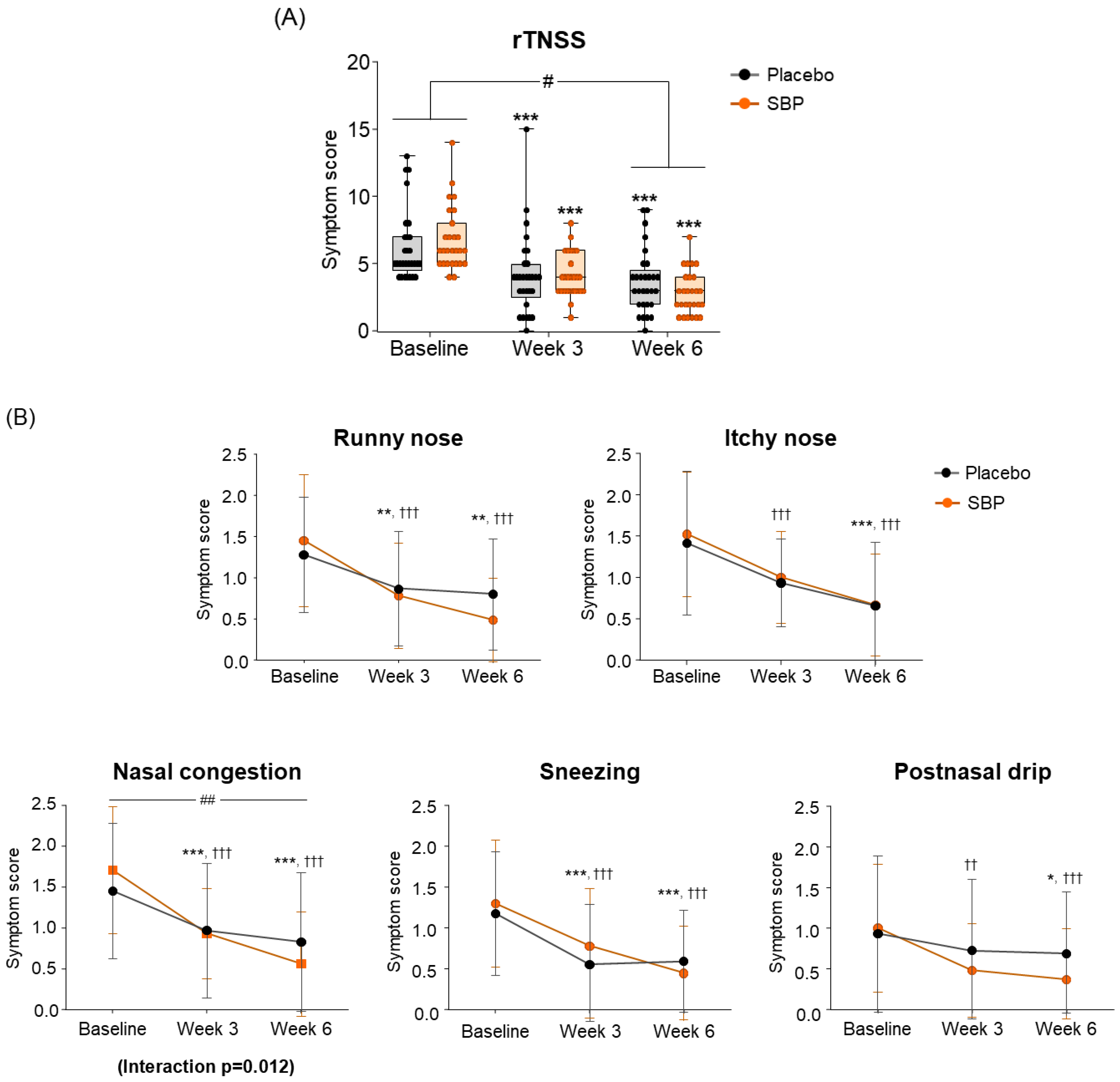
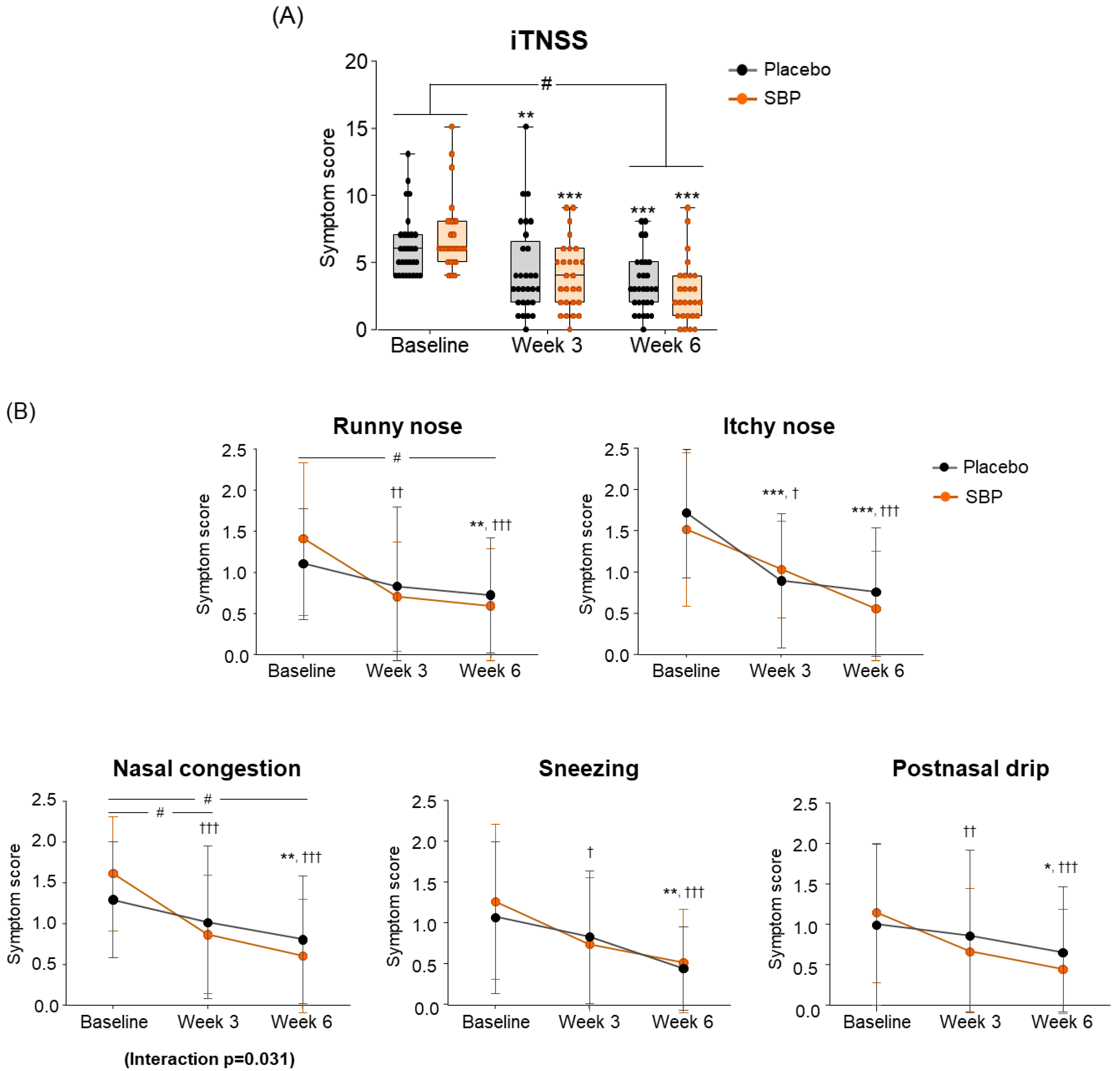
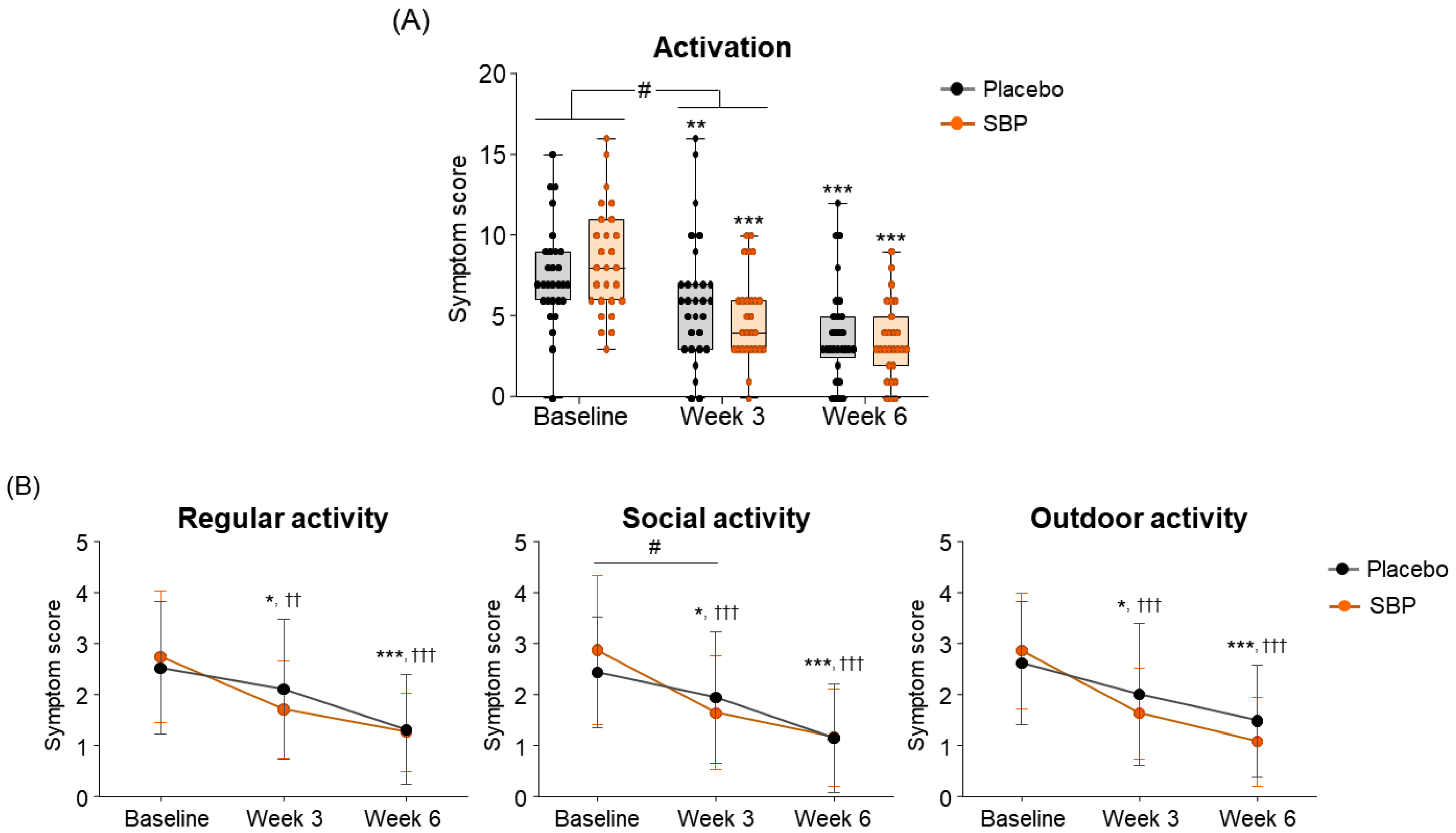

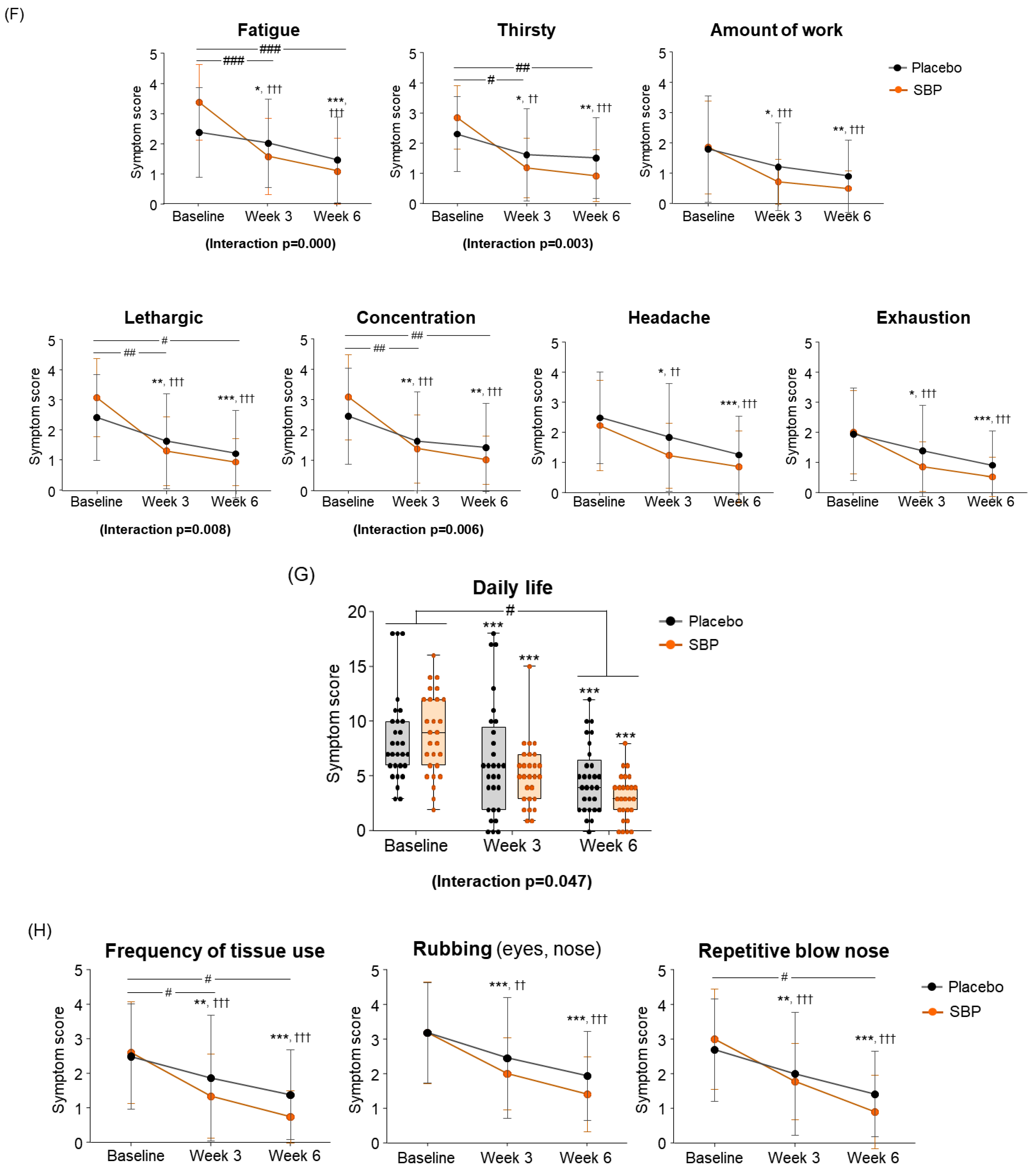





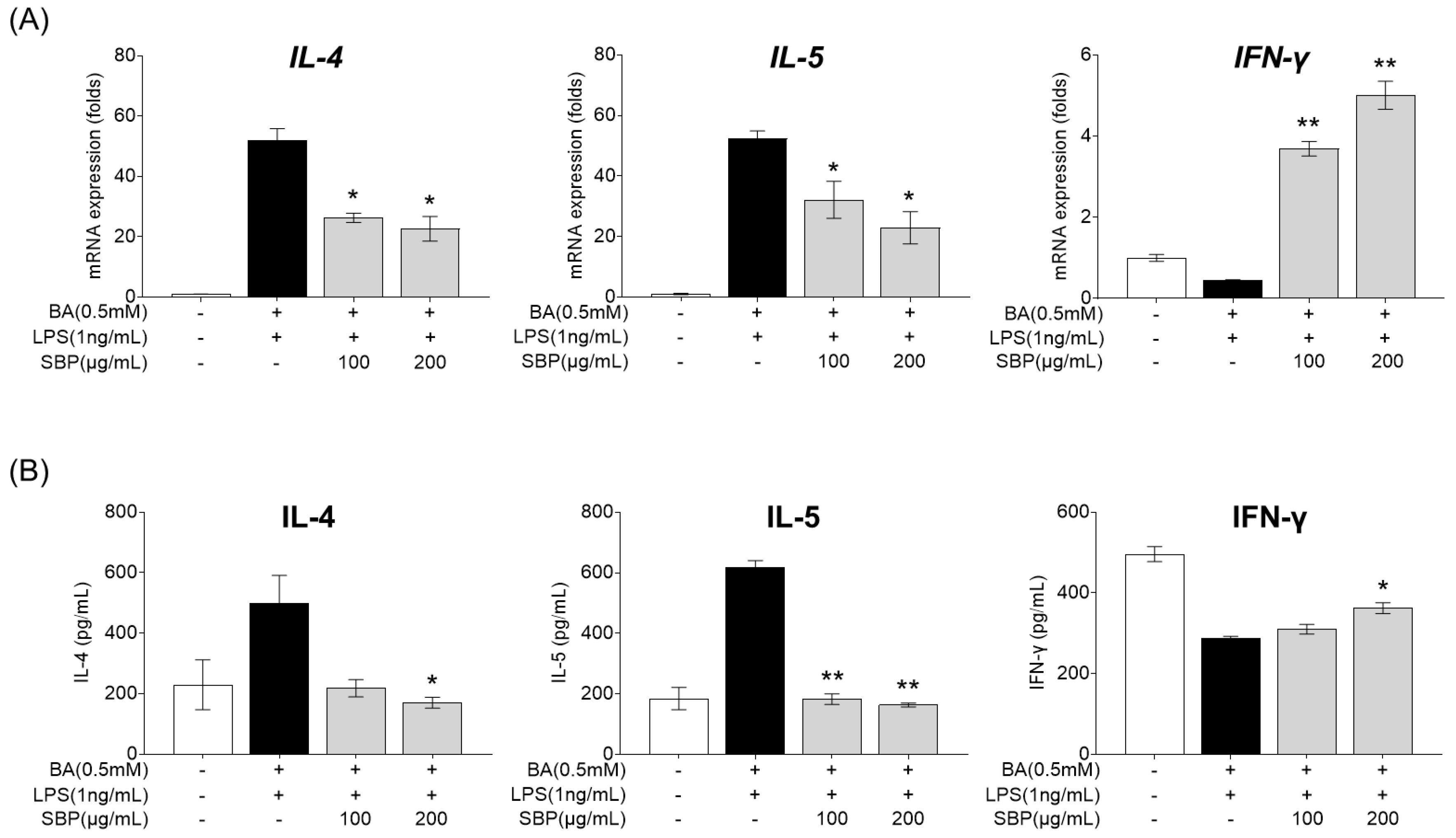
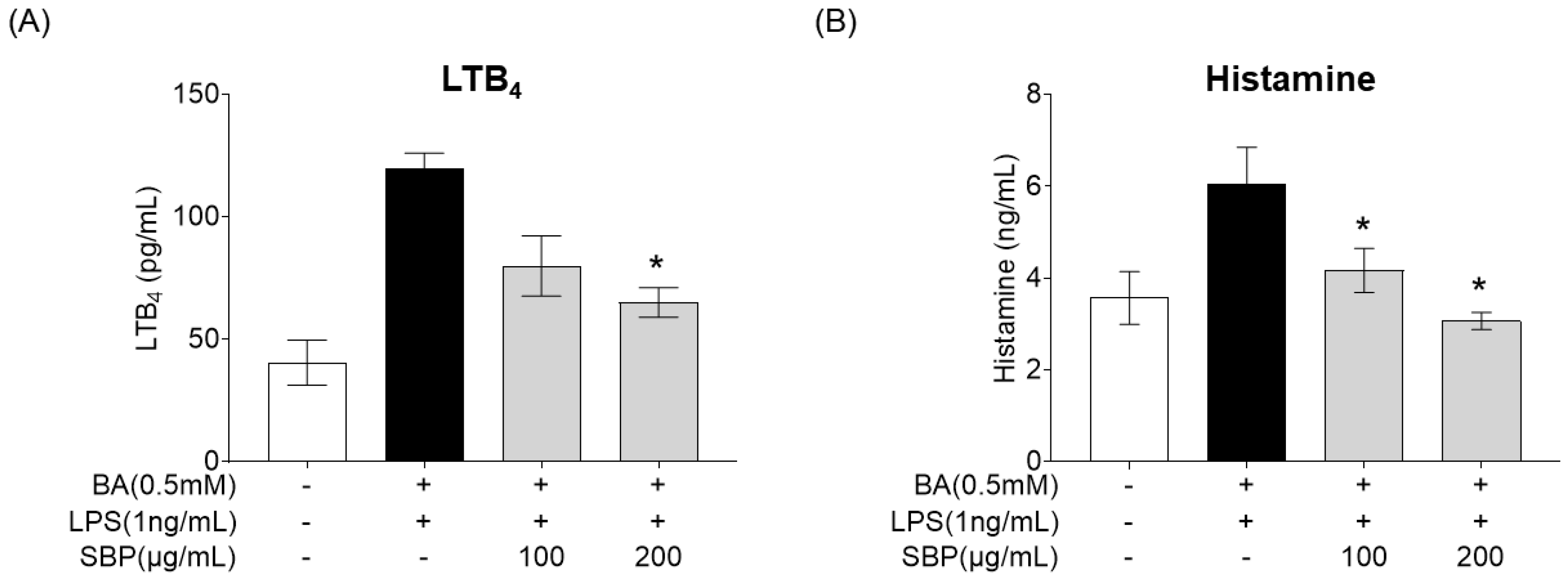

| Gene | Primer Sequences (5′→3′) | |
|---|---|---|
| ECP | Forward | ATAGTTTTCACCCAGAGTCCA |
| Reverse | TGCCCGCATTGCAATGGTGCATCGA | |
| IL-4 | Forward | AACGGCTCGACAGGAACCT |
| Reverse | ACTCTGGTTGGCTTCCTTCCA | |
| IL-5 | Forward | GCTTCTGCATTTGAGTTTGCTAGCT |
| Reverse | TGGCCGTCAATGTATTTCTTTATTAAG | |
| IFN-γ | Forward | TCAGCTCTGCATCGTTTTGG |
| Reverse | GTTCCATTATCCGCTACATCTGAA | |
| GAPDH | Forward | CTGGGCTACACTGAGCACC |
| Reverse | AAGTGGTCGTTGAGGGCAATG | |
| Variables | Treatment Group | p-Value | ||
|---|---|---|---|---|
| Total (n = 64) | SBP (n = 32) | Placebo (n = 32) | ||
| Age (years) | 38.3 ± 11.8 | 38.3 ± 11.9 | 38.4 ± 12 | 0.803 |
| Sex, n (%) | 0.214 | |||
| Male | 13.0 ± 20.3 | 9.0 ± 28.1 | 4.0 ± 12.5 | |
| Female | 51.0 ± 79.7 | 23.0 ± 71.9 | 28.0 ± 87.5 | |
| Height (cm) | 163.8 ± 8.5 | 165.9 ± 9.8 | 161.8 ± 6.4 | 0.093 |
| Body weight (kg) | 64.7 ± 14.7 | 68.9 ± 15.2 | 60.4 ± 13.1 | 0.017 |
| BMI (kg/m2) | 24.0 ± 4.3 | 24.8 ± 3.9 | 23.2 ± 4.5 | 0.076 |
| Systolic blood pressure (mmHg) | 124.0 ± 14.0 | 126.4 ± 15.7 | 121.5 ± 12.1 | 0.166 |
| Diastolic blood pressure (mmHg) | 75.0 ± 10.8 | 76.7 ± 11.3 | 73.3 ± 10.2 | 0.220 |
| Pulse rate (n/min) | 81.1 ± 11.5 | 81.9 ± 11.9 | 80.2 ± 11.3 | 0.562 |
| Medical history, n (%) | 0.258 | |||
| N | 47.0 ± 73.4 | 26.0 ± 81.2 | 21.0 ± 65.6 | |
| Y | 17.0 ± 26.6 | 6.0 ± 18.8 | 11.0 ± 34.4 | |
| Concomitant drug, n (%) | 0.109 | |||
| N | 57.0 ± 89.1 | 31.0 ± 96.9 | 26.0 ± 81.2 | |
| Y | 7.0 ± 10.9 | 1.0 ± 3.1 | 6.0 ± 18.8 | |
| Physical examination, n (%) | ||||
| Normal | 64.0 ± 100.0 | 32.0 ± 100.0 | 32.0 ± 100.0 | |
| Abnormal | 0.0 ± 0.0 | 0.0 ± 0.0 | 0.0 ± 0.0 | |
| Placebo | SBP | |||||||
|---|---|---|---|---|---|---|---|---|
| Baseline | Week 3 | Week 6 | Change | Baseline | Week 3 | Week 6 | Change | |
| TNF-α (pg/mL) | 4.19 ± 1.52 | 4.52 ± 1.72 | 4.41 ± 1.76 | −0.22 ± 1.44 | 4.59 ± 1.85 | 5.00 ± 3.66 | 4.30 ± 2.01 | 0.29 ± 0.89 * |
| IL-5 (pg/mL) | 0.15 ± 0.04 | 0.20 ± 0.15 | 0.14 ± 0.04 | 0.01 ± 0.03 * | 0.18 ± 0.09 | 0.18 ± 0.09 | 0.16 ± 0.05 | 0.02 ± 0.07 * |
| ECP (ng/mL) | 4.60 ± 3.25 | 4.98 ± 3.89 | 4.48 ± 2.56 | 0.12 ± 2.90 | 10.20 ± 10.16 | 9.55 ± 8.23 | 7.23 ± 5.22 | 2.97 ± 6.86 *,# |
| Prostaglandin (pg/mL) | 856.17 ± 03.09 | 944.29 ± 573.18 | 932.20 ± 729.28 | −76.03 ± 254.42 * | 744.97 ± 529.52 | 709.48 ± 389.18 | 714.86 ± 462.25 | 30.12 ± 446.28 |
| Leukotriene (pg/mL) | 98.14 ± 45.24 | 117.74 ± 122.70 | 107.17 ± 80.35 | −9.03 ± 77.95 | 136.05 ± 104.42 | 140.34 ± 112.25 | 126.94 ± 110.57 | 9.11 ± 78.88 |
Disclaimer/Publisher’s Note: The statements, opinions and data contained in all publications are solely those of the individual author(s) and contributor(s) and not of MDPI and/or the editor(s). MDPI and/or the editor(s) disclaim responsibility for any injury to people or property resulting from any ideas, methods, instructions or products referred to in the content. |
© 2025 by the authors. Licensee MDPI, Basel, Switzerland. This article is an open access article distributed under the terms and conditions of the Creative Commons Attribution (CC BY) license (https://creativecommons.org/licenses/by/4.0/).
Share and Cite
Hwang, H.-J.; Yoon, H.; Cho, J.-H.; Lee, S.; Hwang, K.-A.; Kim, Y.J. Immature Sword Bean (Canavalia gladiata) Pod Alleviates Allergic Rhinitis (A Double-Blind Trial) Through PI3K/Akt/mTOR Signaling. Nutrients 2025, 17, 468. https://doi.org/10.3390/nu17030468
Hwang H-J, Yoon H, Cho J-H, Lee S, Hwang K-A, Kim YJ. Immature Sword Bean (Canavalia gladiata) Pod Alleviates Allergic Rhinitis (A Double-Blind Trial) Through PI3K/Akt/mTOR Signaling. Nutrients. 2025; 17(3):468. https://doi.org/10.3390/nu17030468
Chicago/Turabian StyleHwang, Hye-Jeong, Hyeock Yoon, Joo-Hyung Cho, Seong Lee, Kyung-A Hwang, and Young Jun Kim. 2025. "Immature Sword Bean (Canavalia gladiata) Pod Alleviates Allergic Rhinitis (A Double-Blind Trial) Through PI3K/Akt/mTOR Signaling" Nutrients 17, no. 3: 468. https://doi.org/10.3390/nu17030468
APA StyleHwang, H.-J., Yoon, H., Cho, J.-H., Lee, S., Hwang, K.-A., & Kim, Y. J. (2025). Immature Sword Bean (Canavalia gladiata) Pod Alleviates Allergic Rhinitis (A Double-Blind Trial) Through PI3K/Akt/mTOR Signaling. Nutrients, 17(3), 468. https://doi.org/10.3390/nu17030468






